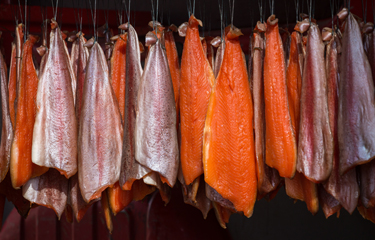The outbreak of the COVID-19 pandemic and the subsequent shutdown of Europe’s foodservice channels and retail limitations will have made any tangible gains by the smoked salmon sector this year highly unlikely.
But with vaccines now being deployed in the U.K. and elsewhere, the coming economic recovery – particularly of the HORECA (hotel, restaurant, and catering) segments – should allow gradual growth to resume, according to a new report from market research company IndexBox.
According to “E.U. – Smoked Pacific, Atlantic and Danube Salmon – Market Analysis, Forecast, Size, Trends and Insights,” gradual population growth, rising incomes, and the recovery of the HORECa industry will lead to a compound annual growth rate (CAGR) of 0.5 percent for the period 2019 to 2030, and this, it projects, will take the market volume up to 246,000 metric tons (MT).
The report states that this year’s HORECA closures led to a significant decrease in the production of bakery and Japanese fish dishes, which in turn depressed the demand for smoked salmon. At the same time, amid concerns about falling incomes, there has been a tendency among consumers to exclude non-staple goods from household purchasing.
However, IndexBox reported European consumers have been cooking at home more, which increased the demand for raw ingredients, as well as for ready-to-eat products.
“Smoked salmon fits those requirements as it is typically sold ready for consumption and it could be stored for a certain period of time,” it said.
The report also acknowledged that as the smoked salmon sector is highly dependent on international trade, the lower transport activity and possible disruption of smoked salmon supply chains pose serious threats to the market.
IndexBox’s analysis further found that the E.U.’s smoked salmon market contracted slightly to USD 4.4 billion (EUR 3.6 billion) in 2019 – even before the coronavirus pandemic began.
In regard to consumption volumes, the main markets for smoked salmon in the E.U. last year were Germany with 39,000 MT, France with 26,000 MT, and the United Kingdom with 24,000 MT. Together, these three countries accounted for 38 percent of the E.U.’s total consumption.
Italy, the Netherlands, Spain, Poland, Belgium, Romania, Denmark, the Czech Republic, Greece, and Portugal followed somewhat behind, collectively representing 45 percent of consumption.
The report states that from 2012 to 2019, the most notable rate of growth among the main consuming countries was by the U.K. market, while smoked salmon consumption in France showed a mild contraction.
Furthermore, exports to France decreased for the second consecutive year, which IndexBox felt was likely to be connected to rising prices.
Overall, the value of smoked salmon imports across E.U. member-states slipped to USD 1.7 billion (EUR 1.4 billion) in 2019, although the total import value increased at an average annual rate of 6.9 percent over the period 2012 to 2019.
In value terms, Germany constituted the largest market for imported smoked salmon in the E.U., with a value of USD 725 million (EUR 597.8 million), and comprising 44 percent of total imports. It was followed by Italy’s USD 292 million (EUR 240.8 million), which represented 17 percent of total imports. France had an 11 percent share.
The smoked salmon import price in the E.U. stood at USD 16,662 (EUR 13,740) per MT in 2019, down 5.8 percent against the previous year. However, over the last seven years, it has increased at an average annual rate of 3 percent.
Photo courtesy of Sander Groffen/Shutterstock







